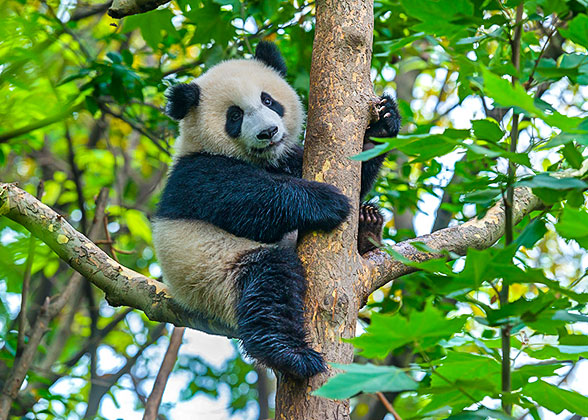China Panda Facts


Typical body shape of bears; black fur on ears, eye patches, muzzle, legs, arms and shoulders, light brown or grey fur on belly and the rest of the coat is white; tail length from 10 to 20 cm (3.9-7.9 inches); the paw has five digits and a modified sesamoid bone that enables the animal to hold bamboo while chewing it; wiry and shaggy hair on the back and soft and long hair on the belly. Those living in the Qinling Mountain have a rounder head, smaller skull and bigger teeth that make them look cat like. While Sichuan pandas have a comparatively large and long head, smaller teeth, more closely resembling other bears.
![]() Preferred Habits:
Preferred Habits:
They like cool and wet areas and do not hibernate. They are naturally solitary choosing to live alone. Although they look plump, they are good at climbing trees, which is instinctive of their ancestor for hunting and escaping from dangers. They like water and usually choose to live nearby the streams. They have good eyesight which allows them to see clearly and find food at night.
![]() Territory:
Territory:
A male giant panda's range of activity is approximately 6-7km in a year and they moved around in half of this range each month. A female's range of activity is 4-5km and they will move around within only 1/10 of their territory. Compared with a yearly activity range of 30km for a black bear, their territory is small.
![]() Timetable:
Timetable:
| 21:00-02:00 | Night Sleep |
| 02:00-07:40 | Breakfast |
| 07:40-10:30 | Morning Rest |
| 10:30-11:00 | Play Time |
| 11:00-12:00 | Lunch |
| 12:00-14:30 | Noon Break |
| 14:30-21:00 | Supper |
In the wild, female pandas are able to reproduce at the age of 6.5, mate and have a baby at the age of 7.5. In capative breeding can commence fall at 3.5 years and produce a baby at 4.5 years. Male ones usually start to mate at 7-8 years old. Pandas are on the rampage when they search for mates, and emit different cries to draw their attention. The breeding season is short, during March to May, and the mating happens in 2-4 days of this period.
Wild female pandas can have 3-4 pregnancies at most, usually one baby each time. They raise cubs alone till they fend for themselves, usually at the age of 1.5 or 2.5 if she does not have new cubs. The pregnancy is usually some 130 days. The possibility of having twin cubs is small. When this happens, they are only capable of raising one. The mothers may leave their cub in a hole or hallow tree as go in search of food for two days or longer. The cubs begin to eat bamboo when they are a year old.
The average life expectancy of wild giant pandas is 15-20 years while the captive ones can live up to 30 years. Currently, the record age for a captive one is 38 years. Their teenage years are before 5 years old, youth during 5-18 years and old age after 18 years.
![]() Location of Natural Habitat:
Location of Natural Habitat:
Mainly in southern Shaanxi, Gansu, Sichuan with 95% living in seven mountain ranges including Qinling, Minshan, etc. Sichuan is the most important habitat, about 80% of China's wild giant pandas. Wanglang National Nature Reserve in Mianyang is the habitat having most wild pandas among the several in Sichuan: Wolong National Nature Reserve (in Wenchuan County), Fengtongzhai Natural Reserve (in Baoxing County), Four Maiden's Mountain Nature Reserve (Xiaojin County), Labahe Nature Reserve (in Tianquan County), Heishuihe Nature Reserve (in Lushan and Dayi Counties), Jintang-Kongyu Nature Reserve (in Kangding County), Caopo Nature Reserve (in Wenchuan County), Dujiangyan Scenic Area, Mt. Qionglai, Mt. Tiantai, Xiling Snow Mountain, Jiguan Mountain-Jiulonggou Valley, Mt. Jiajin, Miyaluo Resort, Mt. Lingjiu-Snow Peak and Mt. Erlang.